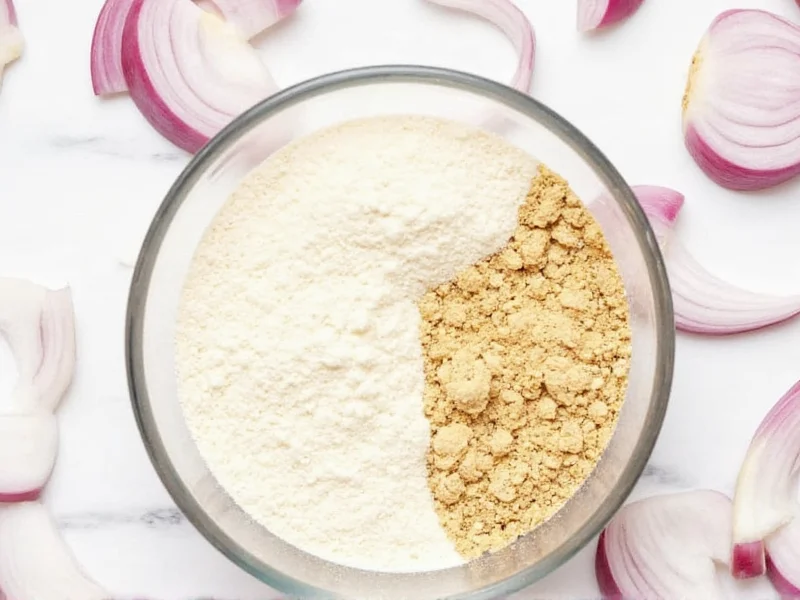Understanding the proper onion to onion powder ratio is essential for consistent cooking results. When substituting dried onion products for fresh onions, the key is recognizing how dehydration concentrates flavor compounds while eliminating water content. This fundamental kitchen conversion affects everything from soups and stews to spice blends and marinades.
Understanding Onion Powder Conversion Basics
Onion powder provides convenient, shelf-stable onion flavor without the preparation time of fresh onions. However, because the drying process removes approximately 90% of the onion's water content, the flavor becomes significantly more concentrated. This concentration explains why you need substantially less powder than fresh onion.
The standard conversion works because fresh onions are about 89% water. When dehydrated to create powder, that water evaporates, leaving behind the flavorful compounds in a much more compact form. This scientific principle forms the foundation of the onion powder to fresh onion measurement ratio that professional chefs and home cooks rely on.
Comprehensive Onion Conversion Reference
| Fresh Onion Measurement | Onion Powder Equivalent | Onion Flakes Equivalent |
|---|---|---|
| 1/4 cup minced onion | 1 tablespoon | 2 tablespoons |
| 1/2 cup minced onion | 2 tablespoons | 1/4 cup |
| 1 cup minced onion | 1/4 cup (4 tablespoons) | 1/2 cup |
| 1 medium onion (about 1/2 cup) | 2 tablespoons | 1/4 cup |
| 1 large onion (about 1 cup) | 1/4 cup | 1/2 cup |
Factors Affecting Onion Powder Substitution Accuracy
While the standard 4:1 ratio works for most applications, several variables influence the perfect conversion:
Onion Variety Matters
Different onion types have varying water content and flavor intensity. Sweet onions like Vidalias contain more water (up to 93%) than yellow onions (about 89%), meaning you might need slightly more powder when substituting for sweet varieties. For red onions, which have similar water content to yellow onions but different flavor compounds, the standard ratio generally applies.
Recipe Type Considerations
Moisture-sensitive recipes like breads or pie crusts require more precise conversion than soups or stews. In dry applications, adding too much powder can affect texture. For baking, use 3:1 ratio instead of 4:1 to prevent excess dryness. In liquid-based recipes like sauces or braises, you can often use the full 4:1 ratio since the liquid content compensates.
Personal Flavor Preference
Some cooks prefer stronger onion flavor. If you're accustomed to robust onion presence in your dishes, consider using 3.5:1 ratio instead of 4:1. For milder applications like delicate sauces or children's food, a 5:1 ratio might be more appropriate. Always taste as you cook and adjust accordingly.
Practical Substitution Techniques
For best results when converting fresh onion to onion powder in recipes:
- Reconstitute powder with liquid: Mix onion powder with 2-3 tablespoons of recipe liquid before adding to allow flavor distribution
- Layer flavors: Add half the powder early in cooking and the rest near the end for complex flavor development
- Adjust seasoning: Remember that onion powder contains no salt, so you may need to increase salt slightly
- Consider cooking time: In long-cooked dishes, reduce powder by 25% as flavors concentrate over time
- Store properly: Keep onion powder in airtight container away from light to maintain potency for up to 2 years
Common Substitution Mistakes to Avoid
Many home cooks make these errors when converting fresh onion to onion powder:
- Using equal measurements (1:1 ratio) resulting in overpowering flavor
- Adding powder directly to dry ingredients causing uneven distribution
- Not accounting for recipe moisture content
- Using old, stale powder that has lost potency
- Substituting without considering the dish's cooking time
When converting recipes that call for caramelized onions, remember that onion powder cannot replicate the Maillard reaction flavors. In these cases, consider using a combination of powder plus a small amount of sugar to approximate the sweet complexity.
Special Considerations for Different Onion Products
Understanding the differences between various dried onion products helps perfect your conversions:
- Onion powder (finely ground): Most concentrated form, use 1:4 ratio with fresh
- Onion flakes (dehydrated pieces): Less concentrated, use 1:2 ratio with fresh
- Granulated onion (medium grind): Between powder and flakes, use 1:3 ratio
- Onion salt: Contains salt (typically 75% onion, 25% salt), adjust salt in recipe accordingly
For international recipes, note that "medium onion" measurements vary by country. In American recipes, a medium onion yields about 1 cup minced; in British recipes, it's closer to 3/4 cup. Always measure your minced onion rather than estimating by whole onion count for precise conversion.











 浙公网安备
33010002000092号
浙公网安备
33010002000092号 浙B2-20120091-4
浙B2-20120091-4